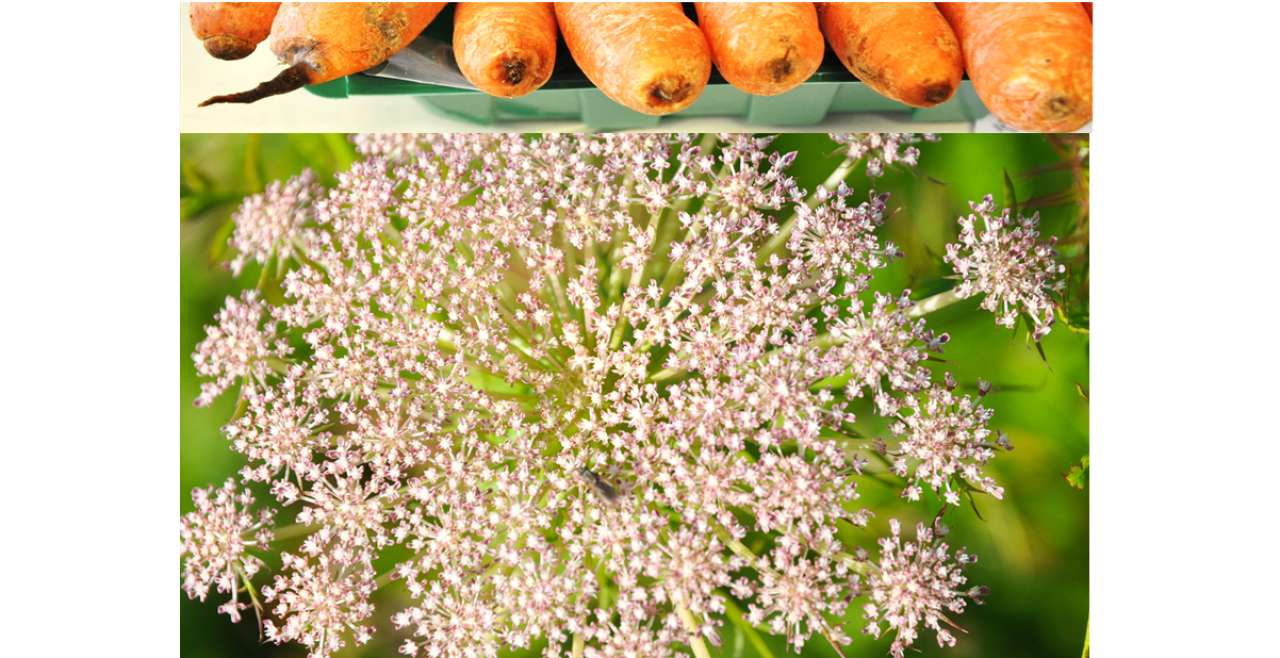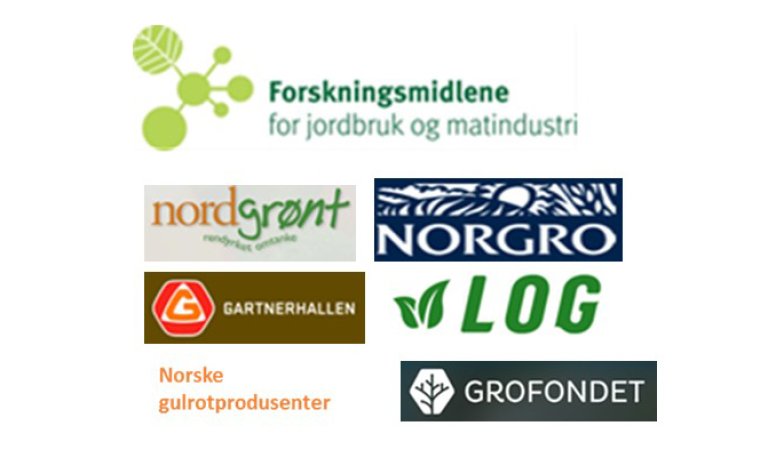Division of Biotechnology and Plant Health
Understanding the causal agent(s) of tip rot to reduce carrot loss and waste within the supply chain (RootCause)

End: jan 2022
Start: feb 2019
Carrot is the main field vegetable in Norway, and it contributes over 461 million NOK per annum. It is stored in cold storages for up to 8 months, but postharvest yield losses reach 40%.
More information
Identification of fungi that cause tip rot of carrot and determine effect of storage temperature and cultivar on tip rot development Effekt av bor- og kalsiumgjødsling på rotfysiologi og cellevegg hos gulrot (Daucus carota ssp. sativus) Prevalence of tip rot and the carrot supply chain actors’ awareness about the disease in Norway Effect of packaging materials and storage conditions on development on tip rot in carrotProject participants
Anna Birgitte Milford Anne-Berit Wold Berit Nordskog Hanne Larsen Mette Thomsen| Status | Concluded |
| Start - end date | 01.02.2019 - 31.01.2022 |
| Project manager | Belachew Asalf Tadesse |
| Division | Division of Biotechnology and Plant Health |
| Department | Fungal Plant Pathology in Forestry, Agriculture and Horticulture |
| Total budget | 10000000 |
In Norway, a disorder of carrot which is tentatively called “tip rot” has been observed with increasing frequency over the last 10 years. A typical symptom of tip rot is discoloration and necrosis starting from the tip of the carrot tap root and progressing upwards. Tip rot significantly reduces root quality and contributes to the high level of carrot rejection during sorting and packaging. The causal agent(s) of tip rot are not known, and it is important to understand how biotic, abiotic and climatic factors affect the development of tip rot.
Carrot is the main field vegetable in Norway, and it contributes over 461 million NOK per annum. It is stored in cold storages for up to 8 months, but postharvest yield losses reach 40%. In Norway, a disorder of carrot which is tentatively called “tip rot” has been observed with increasing frequency over the last 10 years. A typical symptom of tip rot is discoloration and necrosis starting from the tip of the carrot tap root and progressing upwards. Tip rot significantly reduces root quality and contributes to the high level of carrot rejection during sorting and packaging. The causal agent(s) of tip rot are not known, and it is important to understand how biotic, abiotic and climatic factors affect the development of tip rot.


The primary objective of RootCause is to reduce carrot loss and waste caused by tip rot to ensure sustainable carrot production in Norway.
Secondary objectives:
- Determine the extent of the tip rot problem and its correlation with agronomic practices through producer interview.
- Identify the potential biotic causal agent(s) of tip rot, and study pathogen biology.
- Understand the effect of abiotic factors and agronomic conditions on carrot root physiology and tip rot development.
- Reduce postharvest losses due to tip rot by inducing carrot root resistance.
- Understand the effect of packaging material and post packaging environmental factors on tip rot development.
The main focus of RootCause is to identify the causal agent(s) of tip rot and coordinated it with proper management practices to reduce tip rot development. This is also important to maintain the domestic market share of carrot and for sustainability of carrot production in Norway.
Collaboration
The RootCause project involves a multidisciplinary team from national (NIBIO, NMBU, NOFIMA, and NLR), and international (University of Aarhus, and Warwick University) organizations, where participants have experience in plant pathology, agronomy, plant physiology, food science and social sciences.
Publications in the project
Abstract
Carrot is the main field vegetable in Norway and is stored at 0-1°C for up to 8 months. In long-stored carrots, postharvest diseases are problematic. Better knowledge of the causal agents of postharvest diseases can help producers apply appropriate control measures to reduce carrot loss and waste. The objectives of this study were to determine the extent of the tip rot problem and the prevalence of other storage diseases of carrots in different regions in Norway. The study was conducted from 2019 to 2021 by collecting carrots from 16 commercial cold storages, representing four regions. From each storage, representative carrots were randomly sampled, washed, and sorted into different disease categories and healthy carrots. Representative samples from each category were further analyzed in the NIBIO laboratory to identify the causal agent(s) and confirm the disease. Causal agent(s) were identified by symptom and sign description, microscopy and when necessary, DNA sequencing. One or more pathogens were identified from each symptomatic carrot. The incidence of postharvest diseases significantly varied among regions. Taking all years and regions together, only 42% of the carrots were healthy. In other words, 58% of the carrots were with one or more diseases, representing a waste due to diseases alone. Tip rot alone contributed to about 30% of the postharvest loss. Our results indicate that the burden of postharvest diseases of carrots is increasing. This includes diseases like tip rot disease complex, Cylindrocarpon root rot and cavity spot. The results are useful to direct research investigation of the most problematic diseases. Most of the post-harvest diseases of carrots are the result of latent infections that occur in the field, and stress during handling, storage, and processing operations. Hence, postharvest disease control measures should consider the pre-and postharvest predisposing factors of carrots for storage rot.
Abstract
The maturity stage of carrot and the temperature strategy during storage are essential factors in maintaining storage quality during long-term storage. The aim of the study was to examine the effect of maturity and storage strategy on storage quality in different cultivars of carrot (Daucus carota subsp. sativus). Two cultivars, ‘Nominator’ and ‘Romance’, harvested at three different maturity levels were stored with different temperature strategies in small-scale experimental stores. The different maturity levels were obtained by different sowing dates. The study was conducted over 2 years and storage seasons in 2019-2020 and 2020-2021. The carrots were stored with three different temperature strategies with stable temperature at 0, 2 or 0°C interrupted with intervals of 2 weeks with 4°C in February and in March. After six-months storage we found that weight loss was higher (7.8%) after storage when the temperature was not stable during storage (fluctuations up to 4°C in February and March) than at stable temperatures at 0 or 2°C. The number of healthy roots after storage was highest in the most mature carrots (91%) while there were less healthy roots in the least mature roots (85%) (P<0.05). Diseases detected after storage were gray mold (Botrytis cinerea), liquorice rot (Mycocentrospora acerina), tip rot, crater rot (Fibularhizoctonia carotae), Fusarium rot (Fusarium spp.) and cavity spot (Pythium spp.). There was significantly more liquorice rot in Nominator (1.9%) than in Romance (0.6%). There was more tip rot in the least mature carrots (3.3%) compared to the other two maturity levels (1.3 and 1.5%).
Authors
Belachew Asalf TadesseAbstract
No abstract has been registered
Authors
Belachew Asalf TadesseAbstract
No abstract has been registered
Abstract
Temperature and humidity were measured in 28 vegetable stores and corelated to quality of stored vegetable through two storage seasons. The vegetables swede, carrot and celeriac were grown at one site within each of the four regions in Norway ROG, MID, INN and OSL, respectively. After harvesting, the vegetables were weighed and visually assessed for any injuries or diseases and stored in different stores within the same region as grown. Four bags dug down in four storage bins in each store. Temperature and humidity were logged in each bag as well as on the top of each bin and on wall of the storage. In general, we found significant differences in the storage quality between the different storages as well as between regions. Correlating data on quality with temperature data shows for carrot a tendency to an increase in the proportion of fresh roots and reduction in incidence of tip-rot by an increased average temperature during the first two weeks of storage. This corresponds to results from tested various wound healing treatments. An increase in accumulated temperature during the storage period showed a tendency to increase the emergence of tip-rot and reduce the proportion of fresh roots. For celeriac, the effect of temperature varied between years, possibly due to a large difference in quality in the two test years, and it was difficult to draw any conclusion. In swede, the results suggest that a decrease in temperature in the first two weeks of storage increased the risk of the symptom shown as black veins in the phloem. Nutrient status was found to be a possibly predisposing factor for reduced storage quality in celeriac. Balance of boron (B) to calcium (Ca) and zinc (Zn) were studied in two sites. Highest incidence of brown spots and lowest proportion of fresh roots following storage was found in celeriac with the lowest Ca/B ratio in leaves, lowest content of Zn in the leaves and roots and lowest soil pH.
Authors
Torstein KvammeAbstract
No abstract has been registered
Abstract
No abstract has been registered
Abstract
No abstract has been registered
Abstract
No abstract has been registered
Abstract
No abstract has been registered
Abstract
No abstract has been registered
Abstract
No abstract has been registered
Authors
Rizan MohamadAbstract
No abstract has been registered
Abstract
No abstract has been registered
Abstract
No abstract has been registered
Authors
Mette ThomsenAbstract
No abstract has been registered
Authors
Belachew Asalf TadesseAbstract
No abstract has been registered
Authors
Anna Birgitte MilfordAbstract
No abstract has been registered
Abstract
No abstract has been registered
Abstract
No abstract has been registered
Authors
Mette ThomsenAbstract
No abstract has been registered
Abstract
No abstract has been registered
Abstract
No abstract has been registered
